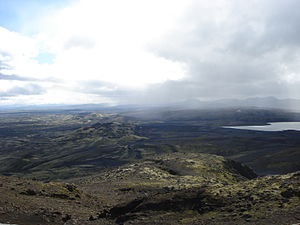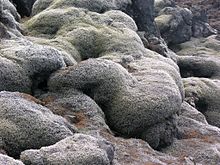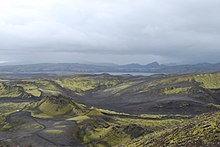Laki crater
| Laki crater | ||
|---|---|---|
|
Western series of Laki craters |
||
| height | 812 m | |
| location | Iceland | |
| Coordinates | 64 ° 4 ′ 12 ″ N , 18 ° 14 ′ 11 ″ W | |
|
|
||
| Type | Crevasse volcano | |
| Last eruption | 1784 | |
|
Eastern Laki crater series |
||
The Laki craters ( Icelandic Lakagígar ) are located in southern Iceland near the Eldgjá fissure . The crater series is assigned to the Grímsvötn volcanic system . One of the reasons for this is that the Grímsvötn erupted at the same time as the Laki craters in 1783 (from August 1783 with interruptions until 1785).
geography
Between the glacier areas of Mýrdalsjökull and Vatnajökull , the so-called “strip land” runs over 50 km with numerous crevasses oriented from southwest to northeast. The area, to which the Eldgjá belongs, is known for some of the most violent volcanic eruptions in Iceland. That is why these districts were popularly called eldhéröð ( Eng . "The fire districts").
The crater series itself consists of about 130 to 140 cinder cones and weld cinder cones as well as two tuff cones , which extend for about 25 km in a south-west-north-east direction and whose orientation runs roughly parallel to the rift valley of the eastern volcanic zone of Iceland. The series of craters was formed during a series of eruptions in the 18th century that lasted from 1783 to 1784. There have been no further eruptions from the crater series.
The eruption from 1783 to 1784
Móðuharðindin ( Icelandic for "Nebelnot") was a natural disaster that occurred in 1783 and 1784 in Iceland . The cause was the eruption of the Laki crater, which even had an impact on the global climate. Isl. Móða means “moisture, haze, fog ” in German.
The eruption of the volcanic fissure of the Laki crater, which was preceded by several earthquakes, began on June 8, 1783 and lasted until February 7, 1784. It is considered to be one of the largest volcanic eruptions documented in historical times. The eruption devastated a significant part of southern Iceland and had an impact primarily on Iceland, but also on the entire global climate. Because of the resulting volcanic winter, there were crop failures and mass deaths worldwide.
Effects in Iceland
Effusive eruption phases
During the eruption of 1783/84, a total of about 14.7 km³ of basaltic lava was ejected from a total of about 130 craters , which covered an area of 600 km². This is the second largest amount of lava ejected in Iceland in historical times after the series of eruptions of the "Fire Gorge" Eldgjá in the years 934–940 AD. In addition, 0.9 km³ of tephra were ejected during explosive eruptions , which classifies the eruption as VEI 4+ .
The effusive phase began on the first day of the eruption, on Pentecost Sunday, June 8th, 1783, with about 1000 m high lava columns. The Skaftá river , through which normally up to 100 m³ / s of water flows, dried up completely on June 11th due to evaporation. The next day, lava flowed down the river basin with great noise in an amount that corresponded to the normal water flow volume of the river. This lava flow did not stop for the next 45 days. When it finally came to a stop, it had completely filled in the 100 m deep gorge of the river over a length of 27 km, covering 17 farms and their lands. Another very extensive lava flow arose in early August and followed the valley of the Hverfisfljót River . The two lava flows are called Ytra-Eldhraun and Eystra-Eldhraun .
The sermons on fire
Pastor Jón Steingrímsson from Kirkjubæjarklaustur became famous for his so-called “fire sermons”. While the congregation was gathered in the church, the lava flow stopped shortly before the church. The pastor published the "fire sermons " ( eldmessa ) directed against the lava flow in 1788 together with detailed reports on the catastrophe under the title Eldrit . They serve science, including volcanology, as an important source. A chapel in Kirkjubæjarklaustur commemorates Jón Steingrímsson.
Gas and ash clouds
The ejected ash clouds darkened the atmosphere and caused a significant drop in temperature in Iceland and large parts of the world. The summers from 1783 to 1785 were unusually short. The land lay beneath the aerosol veil of a cloud of vapor enriched with toxic volcanic gases (especially sulfur dioxide ) and fluoride- containing particles. This is where the Icelandic term "foggy" originated.
The enormous amount of 120 million tons of sulfur dioxide emitted reacted with the water droplets from the clouds to form sulphurous acid and sulfuric acid .
Outgassing of fluorine in Iceland
When the eruptions stopped in February 1784, the Laki craters had emitted 8 million tons of fluorine ; this highly toxic gas rained on the ground mixed with ashes. As a result, the vegetation in certain parts of Iceland died away and harvests were badly failed over several years. A large part of the Icelandic herd of sheep (80%), cows and horses (50%) perished or had to be slaughtered. The result was a famine and people's teeth fell out. Around a quarter of the Icelandic population of around 50,000 at that time had died as a result of the natural disaster by early 1785.
Global impact
1783
The outbreak also had an impact in Western Europe. The 120 million tons of sulfur dioxide that had been ejected into the atmosphere had, in combination with water particles, produced twice the amount of toxic aerosols , which now traveled east with the jet stream and moved in a circle over northern Europe and particularly over France and the British Isles. The sulphurous fog was interpreted as altitude smoke or "dry fog" and lay on June 10th over Bergen , on June 16 over Prague , on June 17 over Berlin , on June 18 over Paris , on June 20 over Le Havre and on June 22nd over Great Britain . The sulfuric acid stressed the lungs and resulted in a higher death rate among farm workers (Chartres region and Great Britain). Ships from North America to Europe almost collided with others because the fog over the Atlantic significantly restricted visibility. On June 20th, Malta was covered in fog so thick that the sun could no longer be seen. There was ash rain in England and Finland. There are numerous reports from all over Europe that mention unusually foggy weather. From September 1783 there were heavy rains and storms.
1784
This was followed by a very cold winter in 1783/84. Around 8,000 more people died in Great Britain than in a normal winter. In the eastern United States of America, the average winter temperatures were 4.8 degrees Celsius below the 225-year average. The entire northern hemisphere cooled by an average of 1.5 degrees Celsius. The natural scientist Benjamin Franklin spoke in 1784 of the fact that "a constant fog had settled over all of Europe and large parts of North America". In the spring of 1784 there was heavy flooding by meltwater. These eruptions are therefore among the most momentous in the last 2000 years.
Scientific debate on the Laki outbreak
Contemporary presentation and discussions
Overall, the outbreaks are unusually well documented. The reports of the above-mentioned Pastor Jón Steingrímsson, Eldrit , are particularly informative. A complete description of the Síða Fires (1788).
A widespread debate developed about the origin of the phenomenon. Many scientists linked it with the earthquakes in southern Italy, which were triggered by fermentation or by electrical fire in the earth's interior. The event is thus related to the then current debate among scientists and interested laypeople of the Enlightenment period about the origin of the rocks, which split in different directions, depending on whether they belonged to the Neptunists - like Goethe - or the Plutonists , also known as Vulcanists .
See also
literature
- Haraldur Sigurdsson: Volcanic pollution and climate: The 1783 Laki eruption . EOS (American Geophysical Union): 601-602, August 10, 1982 (including the original text by Benjamin Franklin from May 1784).
- Jón Steingrímsson (author), Keneva Kunz (translator): Fires of the Earth - The Laki Eruption 1783–1784. Nordic Volcanological Institute and the University of Iceland Press, Reykjavík 1998. ISBN 9979-54-244-6 (English translation of Steingrimsson's notes).
- Jón Steingrímsson: A very present help in trouble. The autobiography of the fire priest . Translated by Michael Fell, Peter Lang, New York 2002 (American University Studies, Series VII, Volume 215), ISBN 0-8204-5206-8 .
- John Grattan, M. Brayshay: Environmental and social responses in Europe to the 1783 eruption of the Laki fissure volcano in Iceland. A consideration of contemporary documentary evidence . In: CR Firth, W. McGuire (Eds.): Volcanoes in the Quaternary. Geological Society, London, Special Publication, Volume 161, 1999, pp. 173-187.
- Philip D. Jones: History and climate: memories of the future? Kluwer Academic, 2001.
- Thor Thordarsson, Armann Hoskuldsson: Iceland. Classic Geology in Europe 3. Harpenden 2002, pp. 111-114.
- John Grattan, M. Durand, S. Taylor: Illness and elevated human mortality in Europe coincident with the Laki Fissure eruption , in: C. Oppenheimer, DM Pyle, J. Barclay (Eds.): Volcanic Degassing , Geological Society, London, Special Publications, Volume 213, 2003, pp. 401-414 ( pdf ).
- John Grattan, Michel Durand, David Gilbertson, F. Brian Pyatt: Human sickness and mortality rates in relation to the distant eruption of volcanic gases: rural England and the 1783 eruption of the Laki fissure, Iceland , in: H. Catherine, W. Skinner (Ed.): Geology and Health. Closing the gap, Oxford University Press, 2003 ( pdf ).
- Manfred Vasold: The Laki eruptions of 1783/84. A contribution to German climate history . in: Naturwissenschaftliche Rundschau. Stuttgart 57/11, 2004, pp. 602-608. ISSN 0028-1050
- John Grattan, Sabina Michnowicz, Roland Rabartin: The long shadow: Understanding the influence of the Laki fissure eruption on human mortality in Europe , in: John Grattan, Robin Torrence (eds.): Living under the shadow. The cultural impacts of volcanic eruptions , Left Coast Press, 2007, pp. 153-174.
- Oliver Hochadel: In nebula nebulorum. The Foggy Summer of 1783 and the Introduction of Lightning Rods in the German Empire , in: Peter Heering, Oliver Hochadel and David Rhees (Eds.): Playing with Fire. A Cultural History of the Lightning Rod. Philadelphia 2009 (American Philosophical Society), pp. 45-70.
- Clemens Wirries: Revolution and the end of the world - The myths about Iceland's volcanoes, at: ZEIT Online, April 7, 2010.
Web links
Photos
Consequences of the laki outbreaks
- Climatic consequences and floods in 1784
- On the consequences of the laki outbreaks abroad
- C. William, ea: Mortality in England during the 1783–4 Laki Craters eruption , Bulletin of Volcanology , Vol. 67, Dec. 2004, p.15-26 (12) (abstract, English)
Scientific Article
- Laki in the Global Volcanism Program of the Smithsonian Institution (English)
Other
- Laki
- Among the Laki eruptions (English)
Individual evidence
- ↑ a b c d e f Thor Thordarsson, Armann Hoskuldsson: Iceland. Classic Geology of Europe 3. Harpenden 2002, p. 111ff.
- ^ Hans U. Schmid: Dictionary Icelandic-German. Buske, Hamburg 2001, p. 160.
- ↑ eruption history of the Grimsvotn system in the Global Volcanism Program of the Smithsonian Institution (English), accessed on August 5 of 2010.
- ^ Þorleifur Einarsson: Geology of Iceland. Rocks and Landscape. Mál og Menning, Reykjavík 2005, p. 68.
- ↑ A Sulphurous Stench: Illness and Death in Europe Following the Eruption of the Laki Fissure (PDF file; 146 kB).
- ↑ a b c Deadly ash cloud. The outbreak of the Laki 1783. Documentary, Great Britain / Germany 2006 (48 min.), Arte ( Memento from August 7, 2016 in the Internet Archive ), 2006 ( video at dailymotion.com).
- ^ Ari Trausti Guðmundsson : Land im Werden. An outline of the geology of Iceland. Reykjavík, Mál og Menning, p. 94
- ↑ Guido N. Poliwoda: Learning from disasters. Saxony fighting the floods of the Elbe 1784–1845. Cologne / Weimar / Vienna 2007. p. 59.
- ↑ “ … that there existed a constant fog over all Europe, and a great part of North America… ” Quoted from kwintessential.co.uk
- ↑ H.-U. Schmincke: volcanism. Göttingen 2000, p. 9f.












